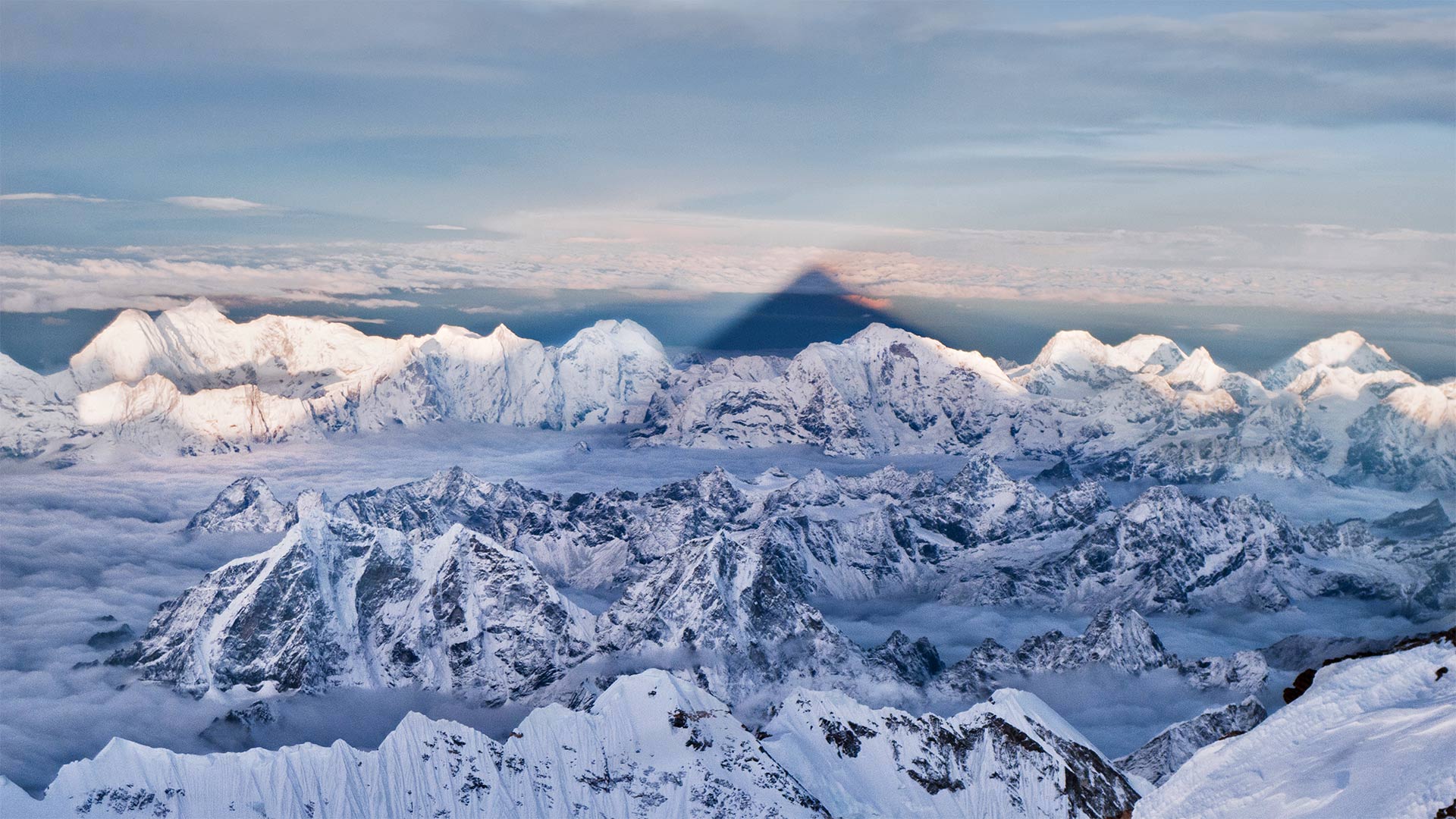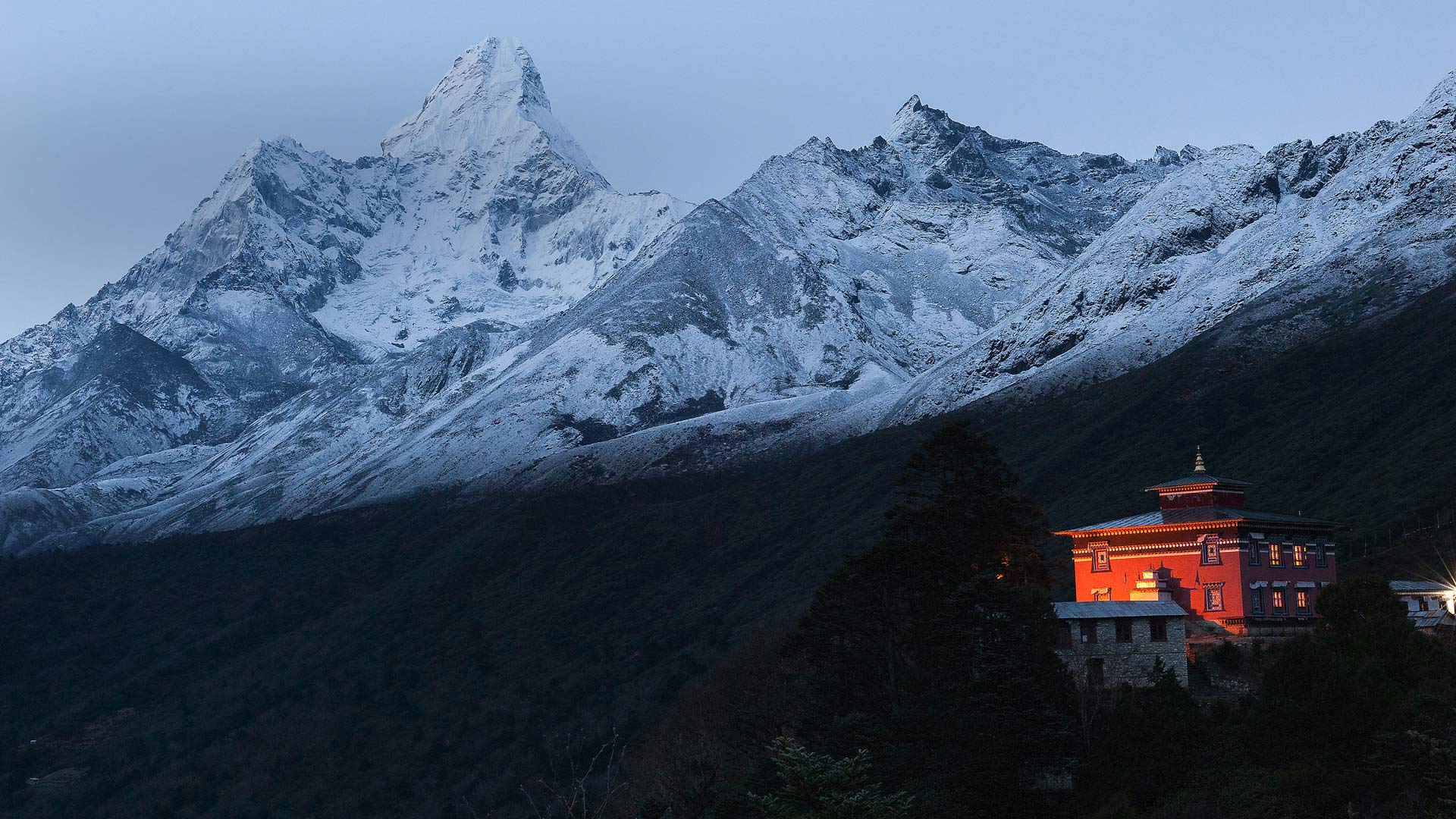珠穆朗玛峰的影子,尼泊尔喜马拉雅西部 The shadow of Mount Everest over the western Himalayas in Nepal (© Kent Karvey/KH Films, Inc./Tandem Stills + Motion)

珠穆朗玛峰的影子,尼泊尔喜马拉雅西部 The shadow of Mount Everest over the western Himalayas in Nepal (© Kent Karvey/KH Films, Inc./Tandem Stills + Motion)
Everest's shadow on the Himalayas
In honor of International Mountain Day, breathe as much of that sweet, crisp mountain air as you can. See that shadow stretching past the Himalayas' craggy skyline? That's cast by Mount Everest, the tallest peak of them all, rising to 29,032 feet above sea level.
Everest is the ideal peak to pair with 2021's Mountain Day theme of sustainable tourism, albeit for regrettable reasons. As the literal top mountaineering destination on Earth, it hosts as many as 600 climbers a season—and also many seasons' worth of trash, discarded gear, and other waste. When Nepal launched a program to remove a staggering 10 tons of garbage in 2019, they found 3 tons in just the first two weeks.
The case of Everest is a standout reminder that wherever in the wilderness we go, it's our responsibility to leave no trace—or as eco-conscious climbers say: 'What goes up must come down.' Let's do our part to keep our beautiful mountains clean, no matter how tall, and maybe someday Everest will cast its shadow over a land free of trash.
喜马拉雅山上的珠穆朗玛峰阴影
为了纪念国际山地日,尽可能多地呼吸那甜美、清新的山地空气。看到那阴影从喜马拉雅山崎岖的天际线延伸过去了吗?这是由珠穆朗玛峰铸造的,珠穆朗玛峰是所有山峰中最高的,海拔29032英尺。
珠穆朗玛峰是与2021年可持续旅游的山日主题相匹配的理想山峰,尽管出于令人遗憾的原因。作为地球上名副其实的顶级登山目的地,它一个季节接待多达600名登山者,也接待了许多季节价值的垃圾、废弃装备和其他废物。2019年,尼泊尔启动了一项清除10吨垃圾的计划,在头两周内就发现了3吨垃圾。
珠穆朗玛峰的例子突出地提醒我们,无论我们在荒野中走到哪里,我们都有责任不留下任何痕迹,或者就像有生态意识的登山者所说的那样:“上升的东西一定会下降。”让我们尽自己的一份力量保持我们美丽的山脉清洁,不管它有多高,也许有一天珠穆朗玛峰会在一片没有垃圾的土地上投下它的影子。
喜马拉雅山脉中的Tengboche修道院,尼泊尔 Tengboche Monastery in the Himalayan Mountains, Nepal (© Kyle Hammons/Tandem Stills + Motion)

喜马拉雅山脉中的Tengboche修道院,尼泊尔 (© Kyle Hammons/Tandem Stills + Motion)
In the Himalayas for International Mountain Day
The steep, angular summit of Ama Dablam rises behind Tengboche Monastery, a Tibetan Buddhist site resting at over 12,000 feet. Ama Dablam means 'mother's necklace': Its swooping shape is thougth to evoke a mother cradling a child, and a dangling glacier on its southwest face is believed to resemble the religious pendants many Sherpa women wear. Situated in the nearby Khumbu Valley, Tengboche Monastery is a stop on the Sacred Sites Trail Project, a self-guided trek through holy places that dot Nepal's Sagarmatha National Park.
We're showing it to you today for International Mountain Day, recognized each December 11. Created by the United Nations in 2003, the observance recognizes the challenges faced and overcome by high-elevation populations. Among these mountain people are the Sherpas, who live here, high in the Himalayas, and haul scarce resources by backpack or yak over terrain where wheels are useless. Many Sherpas make dangerous livings as mountaineering guides. The 2019 theme for International Mountain Day, 'Mountains Matter for Youth,' recognizes the many young people who live in such mountain settlements. Mountain Day events worldwide will educate children and adults in ways to preserve precious mountain resources, not only for future generations but also the 1.1 billion people who call mountains home today.